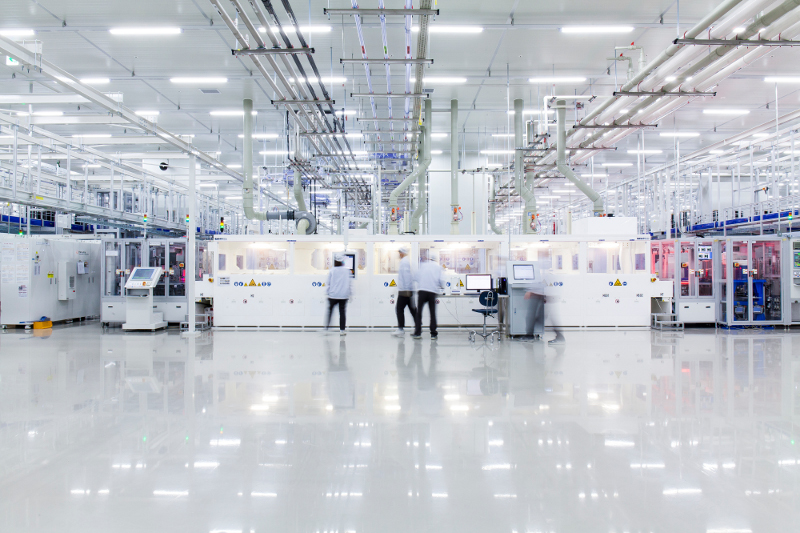pv magazine has learned that Hanwha QCells has already started building its solar panel factory in Turkey, although there will also be an official ceremony marking the construction on 21st November. The company aims to start producing its first solar panels in Turkey by the beginning of 2019.
Hanwha QCells’ factory in Ankara will specifically produce Q.antum cells and modules. The Q.ANTUM cells are based on Passivated Emitter Rear Cell (PERC) technology, which was developed in Hanwaha QCells’ research centre in Germany in 2011 and Hanwha QCells began producing modules based on Q.ANTUM in 2012. Apart from the factory in Ankara, Q.ANTUM cells are also produced today in South Korea, China and Malaysia, while the PERC technology can be used to produce both monocrystalline and polycrystalline modules.
The factory in Ankara, Turkey will most possibly produce monocrystalline cells as the main production line.
According to information gathered by pv magazine, the Ankara-based factory will have an initial capacity of 500 MW, and there are also plans to increase the output at a later stage. The factory will also produce the panels for Turkey’s 1 GW solar PV farm in Konya.
The earthquake risk factor
pv magazine understands that South Korea's Hanwha QCells together with Turkey's Kalyon Holding have taken the decision to build Turkey's vertically integrated solar panel factory in the capital city Ankara, due to high earthquake risks in alternative sites.
In August, pv magazine reported that Hanwha QCells and Kalyon Holding plan to inaugurate the construction of the factory by the end of November.
However, when the news about building the factory in Ankara broke in the summer, many expressed surprise or even doubts about the chosen location.
Turkey’s Solar Energy Society Solarbaba for example told pv magazine then that “the module production may take place in Ankara but most probably the ingot-wafer production will take place in another harbour city (like Istanbul, Izmır or Mersin) which is much more feasible due to logistics and existing infrastructure (water treatment, power lines etc).”
Solarbaba’s hesitation made sense. In fact in July, LM Wind Power, a manufacturer of wind turbine blades and a subsidiary of the USA’s General Electric, selected the Bergama Organized Industrial Zone in the port city of Izmir to inaugurate the construction of its Turkish wind turbine manufacturing facility, with an initial annual capacity of 500 MW.
The nuclear energy debate
Hanwha QCells’ strategic decision based on earthquake concerns and risks brings a new angle on Turkey’s energy debate. And this is a view that Turkey’s government has tried to ignore or downplay.
Turkey’s AKP party-led government has said that 90 percent of the country’s electricity in 2023 will be equally provided by gas, coal and renewable energy plants (30 percent each), while nuclear power will provide the remaining 10 percent.
Based on this plan, the government has licensed the country’s first nuclear power plant at Akkuyu, in Mersin Province. This is the province where the Mersin port city is also located. All four of nuclear reactors at Akkuyu are planned to start operation by 2023, totalling 4.8 GW of installed power capacity. Turkey’s government has also signed memoranda of understanding (MoU) or is in talks with more stakeholders concerning the development of further nuclear power plants.
Nuclear energy critics though have long argued that Turkey’s high levels of seismic activity is a major threat to the country’s nuclear safety, while others point out that nuclear safety requires institutional transparency at the highest level and that is far from being the case in Turkey.
Hanwha QCells’ strategic decision to build Turkey’s first integrated solar panel facility in Ankara due to the low seismic activity of the Ankara region reinforces the nuclear safety debate in Turkey with the most apparent and strong manner. If a company is willing to undergo less favourable logistics to avoid the earthquake risks, why a government risks its people lives to build nuclear plants?
On the contrary, Turkey’s target of solar PV by 2023 is 5 GW of installed capacity, which translates to only 2.7% of the overall projected power capacity of 180 GW in 2023.
This content is protected by copyright and may not be reused. If you want to cooperate with us and would like to reuse some of our content, please contact: editors@pv-magazine.com.



By submitting this form you agree to pv magazine using your data for the purposes of publishing your comment.
Your personal data will only be disclosed or otherwise transmitted to third parties for the purposes of spam filtering or if this is necessary for technical maintenance of the website. Any other transfer to third parties will not take place unless this is justified on the basis of applicable data protection regulations or if pv magazine is legally obliged to do so.
You may revoke this consent at any time with effect for the future, in which case your personal data will be deleted immediately. Otherwise, your data will be deleted if pv magazine has processed your request or the purpose of data storage is fulfilled.
Further information on data privacy can be found in our Data Protection Policy.